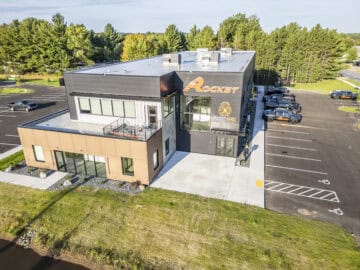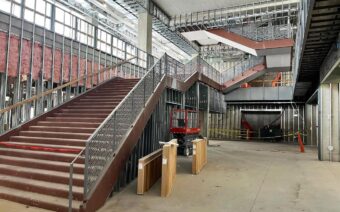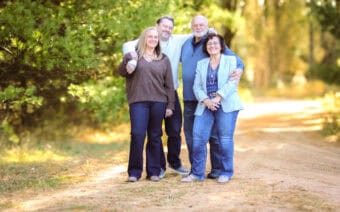
June 10, 2024
WAUSAU – Over the years, the Samuels Group has managed hundreds of construction projects ranging from government offices, sports stadiums, healthcare facilities and public safety buildings.
Now, the firm is rolling onto its next major project – the $15-million renovation of the National Railroad Museum, formally known as the Fox River Expansion.
Vice President of Operations Kurt Berner said after 25 years with The Samuels Group, he cherishes the collaboration and shared sense of accomplishment of the work as much as ever.
“The excitement of it is finding what the challenges are, finding the best way to solve those issues and then getting a plan in place – I enjoy that,” he said. “There are days it’s difficult – but there are also days the challenge is rewarded when you’re able to see success moving along.”
With the Fox River Expansion progressing since The Samuels Group broke ground in early May, National Railroad Museum CEO Jacqueline Frank said she has likewise valued the firm’s approach to overcoming complexities.
“With a project as unique as our Fox River Expansion, I appreciate how much planning and advanced work they try to do to keep the project moving forward throughout the process,” she said. “They are collaborative and treat the museum as a client and an equal in the project.”
Building together
Berner said The Samuels Group is just the right size – large enough to take on major projects, yet able to personally connect and foster lasting relationships with individual clients.
“What we do is get to know them, get to know what their needs are with a building and then put that building together for them that’s going to serve them for a good period of time,” he said. “We’re a personable group – at least that’s what our clients have said.”
As one of the various organizations that interviewed to manage the National Railroad Museum’s project, Frank said The Samuels Group team stood out for its creative ideas, practical expertise and overall ethos.

She said the firm treated her like “a comprehensive project partner.”
“There was no ‘hard sell,’” she said. “They wanted to see every part of the project succeed, and as we have worked together, we have found them to always look out for the museum’s best interests.”
Similarly, Berner said the firm does “very little hard bid work” – rather, most of its projects are based on the recommendations of architectural firms or previous clients with whom The Samuels Group has previously collaborated.
“We like to get that relationship early on so we become a trusted partner of them and we’re guiding them,” he said. “A lot of our clients – this may be the first large project they’ve done, or it’s been a long time since they’ve done a large project, and they need somebody to give them a heads up on, ‘here’s what’s going to happen on this space – we’ll guide you through it.’ And that’s what we’ve been giving to clients.”
Berner and Frank said for the Fox River Expansion, The Samuels Group is working with the architectural firm Berners Schober, a Green Bay-based, long-time collaborator of the firm.
“Berners Schober, Samuels Group and I work closely on all of the elements of the project,” Frank said. “I take part in weekly meetings and have day-to-day input with Samuels Group – our construction managers – to ensure the museum’s daily operating needs are met, while we hit the goals for the new addition.”
Master planning
Though Berner said he and his firm work consistently with clients to manage short-term targets, he said The Samuels Group will recommend a strategy of master planning – “looking at the big picture” – when conversations suggest a project will require multiple phases.
“When we are brought in, there is usually a need that’s been identified by either a committee or an individual, and then what I like to do is start to evaluate – is the need there and is it consistent with the message I’m hearing?” he said. “You want to make sure you get to the long-range plan and do it the right way.”
Viewing projects through the perspective of master planning, Berner said, encourages a phased approach, considerately ordered for the sake of efficiency.
“If I work with a county and they need a highway shop, a jail and a courthouse, we need to figure out what’s its priority,” he said, “so we don’t have to come back and redo phase one when we’re going to do phase two and phase three.”
Berner said The Samuels Group’s master planning mindset can at times be misinterpreted as the firm trying to go beyond a client’s intended scope – “that’s never our intent.”

“I’ve got some owners where they come in and – because they have a need – they’ll spend $2 million to fix one specific thing, but they didn’t look at the entire campus and say, ‘rather than spend $2 million we’re going to regret in five years, let’s reevaluate that,’” he said. “‘We may have to spend $5 million – but we won’t have to touch it for 20 years.’”
Each client, Berner said, is unique, and “we respect their position.”
“But we also have to be confident enough in our recommendation that we’re warning them and giving them a heads-up, and then the final decision is theirs,” he said.
Delegation by design
The Samuels Group builds anywhere between 35 to 60 projects a year, which Berner said primarily starts with him engaging in initial, exploratory discussions.
“A lot of what I do is working with our clients when they first come up with an idea for a project, and then I work with them through the preplanning and preconstruction efforts,” he said. “I’m helping them with financing, land acquisition or finding land and putting the documents together for us to get pricing. Then I hand the project over to my project management team.”
Berner said after beginning his career at The Samuels Group as a carpenter, he would later become a superintendent – overseeing “the entire field operations for our company” – before earning his promotion to vice president.
His past field experience, he said, informs his ability to stay connected to projects throughout their lifecycles, while maintaining regular conversations with clients and team members.
Berner said the firm can complete so many projects not by multi-tasking, but by growing its staff and enabling team members to focus exclusively on one project at a time.
“It’s one of the things we pride ourselves on – that field team is specific to that job, and they’re there from the beginning until the end of the project,” he said.
Projects can last anywhere from six to 30 months, Berner said, and it’s up to him to assemble these field teams with well-rounded talents and complementary personalities.

What starts with cohesion and synergy, he said, leads to finished projects, which all team members find rewarding.
“When we do the ribbon cutting at a facility and I watch my teams, they take pride in that,” he said. “I know there are some from our team who will drive around and look at the buildings they built years later – because they’re still standing, still functioning and still looking great. You can take some sense of accomplishment from that.”
Full steam ahead
Berner said he works to ensure The Samuels Group’s clients experience those feelings of pride along the way as well.
“Throughout my career, I’ve been trying my best to have (clients) understand the process, get them engaged and have them take ownership – so they feel an accomplishment when it’s done as a team,” he said. “It’s not just they hired us to do the building – we all did it together.”
Concerning Frank and the National Railroad Museum, Berner said the in-progress successes can also be shared among the expansion’s many donors.
In addition to a state grant of $7 million, private donors are raising funds for the remaining $8 million in construction costs.
Presently, per the museum’s website, 86% of the $15 million goal has been met.
Frank said she’s excited about the local impact of the expansion, as well as bolstering the congressionally designated museum as a destination for locomotive and railway enthusiasts from around the world.
“This is something that will allow the museum to become more financially sustainable as a business, but more importantly, will allow us to serve more people in the community through educational programs for schools, youth groups, special needs children and advanced learners (with) family-oriented exhibits and a place for the community to gather,” she said. “Our economic impact stands at more than $20 million a year. We expect (the expansion) to double that impact, supporting our community businesses and residents.”
To help achieve this impact, The Samuels Group will add more than 25,000 gross square feet to the facility, including the new utilization of 5,000 square feet of riverfront and consolidation of the museum’s rolling stock, as the various locomotives and train cars had previously been displayed throughout separate buildings.
“There’s going to be a ton of glass, so you are going to see a lot of daylight come in on the addition we’re putting on there,” Berner said. “We’re building a mezzanine because they wanted to have a view of those (train) cars from all aspects – above them, next to them and in front of them – and making this entire atrium where the main thing you’re seeing is the cars, but the building around it enhances the majesty of those cars. It’s going to be a cool deal.”
In addition to helping formulate a master plan, Berner said The Samuels Group has also supported the museum by attending fundraising meetings, creating and presenting promotional videos and answering donor questions – going as far back as 2016 when the initiative was first announced.

“As a partner looking for fundraising, we told them we want to be all in,” he said.
With phase one begun, Berner said based on prior experience, he anticipates the progress will encourage more funding.
“What I’ve noticed is when you get to that first step, people will say, ‘well, what else were you thinking?’” he said. “And then you’ll see there will be donations that start to help with the second phase because of the success of the first phase. I’m excited to see that move forward. I’m excited for Jacqueline (Frank) because if there’s one individual who has not given up through the course of this entire time, it’s been her.”
Berner said The Samuels Group relishes the responsibility inherent to its major projects.
For the Fox River Expansion, he said he’s accountable regarding his partnership with Frank and the trust of the donors and the hundreds of thousands of people who will enjoy the museum in the coming years – whether for field trips, weddings or personal interest.
“Our team understands that (responsibility), and we don’t take it lightly,” he said. “We understand these are private dollars. Some people took money out of their own pockets and invested in this facility.”
The project, Berner said, represents the National Railroad Museum and the community, Green Bay and the State of Wisconsin.
“We’re thankful for the opportunity to be a part of it,” he said.
Frank said she is likewise thankful to have partnered with the firm.
“The Samuels Group is doing a great job on the project to date,” she said. “I trust the employees I have worked with throughout this project. They have been extremely detail-oriented, and I am confident the finished project will be something of which everyone can be proud.”
The project has an anticipated completion date of July 19, 2025.
For more information on The Samuels Group, visit samuelsgroup.net; and for more information on the National Railroad Museum and its expansion, check out nationalrrmuseum.org.
 New North Summit showcases ‘the power of collaboration’
New North Summit showcases ‘the power of collaboration’ ‘I’d rather retain employees than retrain new ones’
‘I’d rather retain employees than retrain new ones’







